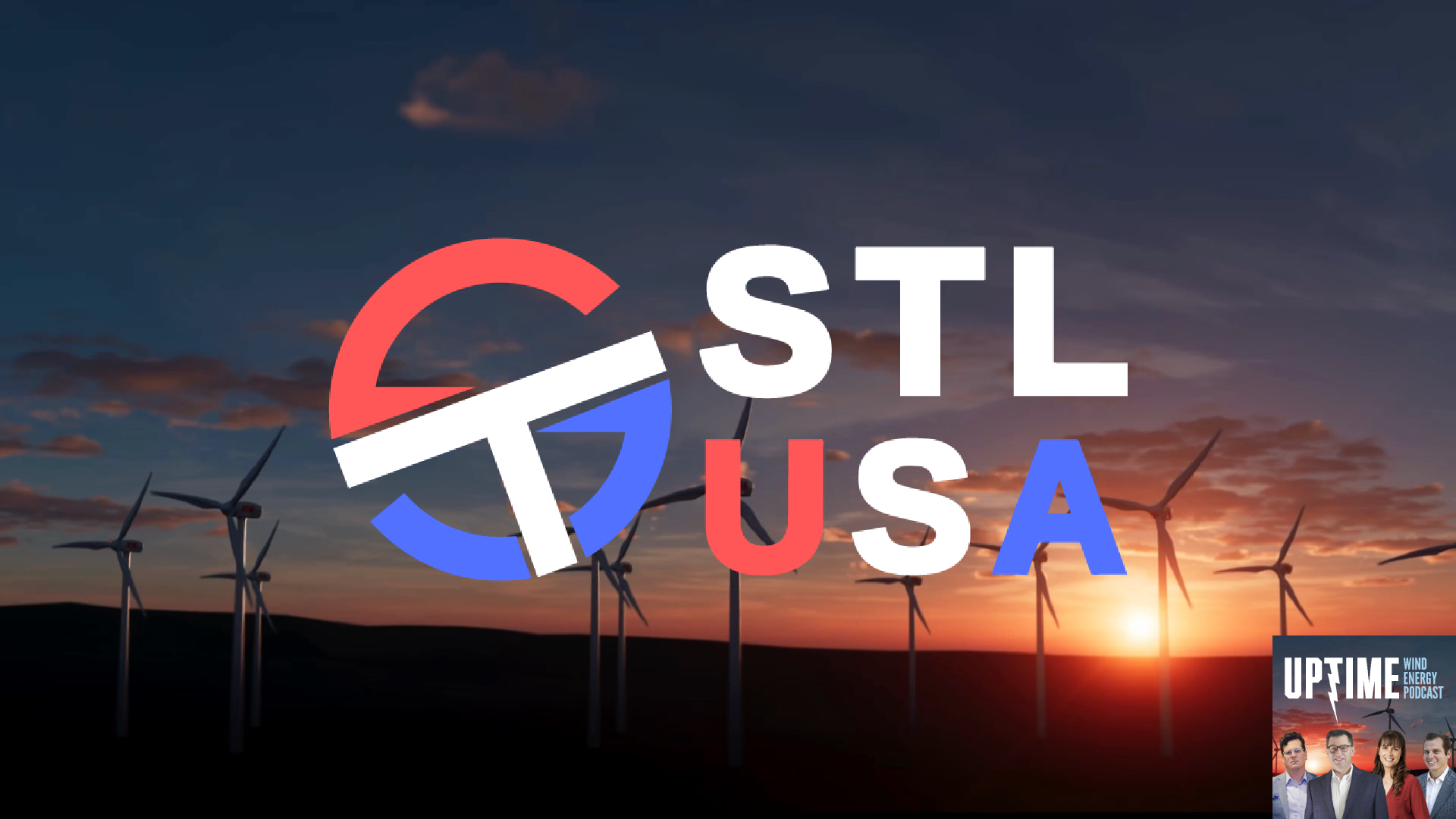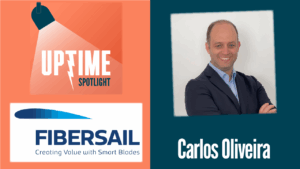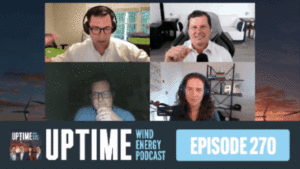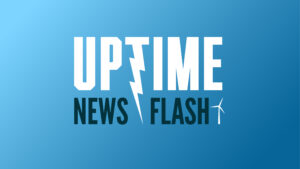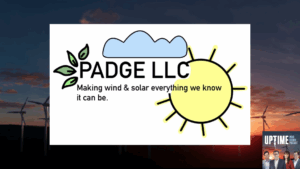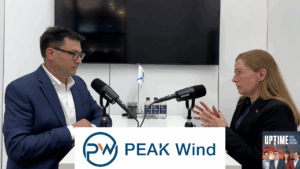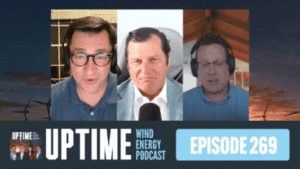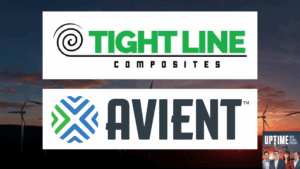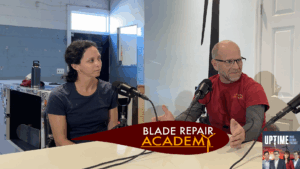Podcast: Play in new window | Download
Allen Hall and Joel Saxum speak with Brandon McKelvain and Jeremy McKelvain from Safety Technology USA (STL) to discuss their trailblazing WindStart program. They visited STL’s impressive training facilities in Abilene, Texas and discovered how the organization is addressing the critical shortage of wind technicians through hands-on, industry-focused education.
Sign up now for Uptime Tech News, our weekly email update on all things wind technology. This episode is sponsored by Weather Guard Lightning Tech. Learn more about Weather Guard’s StrikeTape Wind Turbine LPS retrofit. Follow the show on Facebook, YouTube, Twitter, Linkedin and visit Weather Guard on the web. And subscribe to Rosemary Barnes’ YouTube channel here. Have a question we can answer on the show? Email us!
Pardalote Consulting – https://www.pardaloteconsulting.com
Weather Guard Lightning Tech – www.weatherguardwind.com
Intelstor – https://www.intelstor.com
Allen Hall: Welcome to the Uptime Wind Energy Podcast. I’m your host, Allen Hall, along with my co host, Joel Saxum. The U. S. wind industry needs to train thousands of new wind turbine technicians in the coming years to meet our ambitious goals for wind energy deployment. And today we’re joined by Brandon McKelvain training manager at Safety Technology USA.
Better known as STL. Also, Jeremy McKelvain who is the WindStart program manager at Safety Technology USA. Safety Technology USA, which is commonly called STL for short, is a leading wind technician training organization that provides industry standard accredited courses. Their goal is to help build the wind workforce.
of the future by training safer, more competent entry level and intermediate technicians. Joel and I visited the Safety Technology USA training facilities in Abilene, Texas recently. So if you haven’t been to Abilene, you should visit their facility. It’s pretty impressive. There we met with Brandon, and we’re really impressed by the level of training equipment and the variety of training programs.
So Brandon, Jeremy, welcome to the program.
Brandon McKelvain: Yeah, thank you, Allen.
Allen Hall: We need thousands of wind technicians. And right now, especially in West Texas, where you guys are there’s a huge demand for technicians that are trained and are knowledgeable in the wind industry. And, one of the, one of the programs you have To do that is the wind start program.
And I want to start there because I want to everybody understand what is the wind start program. And if you want to get into wind, why would you choose that program?
Jeremy McKelvain: What we do is we go out to career fairs trade schools, community college. advertise WindStart. Yes, it is STL or safety technology but it’s a program for it.
We get them interested and tell them what we offer through our WindStart program at safety technology, get them interested and then get them signed up for these classes. Give them their relevant training, all their certifications give them some extra training as well. That’s a little bit more technical to prepare them for an entry level job into the wind industry.
And then connect them with our partners that we have, our customers that we have for interviews, try and get them hired on right away. You mentioned that we have thousands of people that we need to hire. By 2030, it’s estimated that we need to hire close to 500, 000 bodies for the wind industry.
So doing this as a wind star program as the manager go in and we try and find those bodies there. You get good paying jobs. You have a reliable career. And for me, my whole thing was, I love helping people. I love helping people and guiding people. I’ve done it for 20 years in the Air Force. Now I just transitioned into this, so that’s what the windstar program is a way to introduce people into the wind industry.
Let’s be real. Let’s face it. Renewable energy is the way of the future and through safety technology, we can train those people through the windstar program and get them in an amazing career in wind as a wind technician. That’s it.
Joel Saxum: So you guys are going to high schools, community colleges what other kind of community outreach you do you guys do?
Cause you’re actually being like the boots on the ground, going and grabbing these people. Cause that’s what the industry needs, right? We know there’s training centers dot, dot it all over the place, but that effort to actually be the people that are going in talking to who could be these candidates and bringing them in to get them to that training.
That’s what’s really needed. So you guys are actually doing the boots on the ground activities as well.
Jeremy McKelvain: I went to one in Roswell, New Mexico last week that was for the job corps, for students young people who were either didn’t finish high school and they’re going back to finish their diploma, get their GED and learn some trait.
They reached out and wanted to see if we could, If we could attend. And I went and those people, they were extremely excited to see me. The students were, but also the director of the job corps and some of their instructors that taught their electrical training, their painting, their construction, their plumbing.
It’s just getting our voice out there, our name out there, and getting people interested for to basically spread the word on.
Allen Hall: So who is your typical candidate? What, like where, what’s their background education level? What are they looking to do for, to further their career?
Jeremy McKelvain: A lot of them know people, either friends or family that have been in the wind industry, and they know about it.
They want to do it. They just don’t know how to get into it. Or we’ll have recent high school graduates. People that did not finish a four year degree that want a job, want a good, reliable, good paying job with benefits just like our partners have. And those are the ones that really seem to pique the interest.
Somebody that wants to make something, make a better life for themselves and their families.
Allen Hall: And are they primarily based in Texas or are they coming from elsewhere?
Jeremy McKelvain: Right now we have traveled mainly through Texas. Thank you But I have had people reach out to me from Illinois, Oklahoma, Texas, New Mexico Iowa, South Africa.
I’ve had people from the UK reach out. We are, we’re not going to discriminate. And that’s one of my big things that I definitely learned in the military is provide people a chance. Diversity makes your workforce. And different points of view, work ethics. That’s what we want. We want to give people a chance.
We want to give them the tools to succeed in what we’re doing and what we can provide.
Joel Saxum: Yeah. So right now we’re talking about the wind start program. So when someone goes into the wind start program, what can they expect as far as costs, the act of education, they come out of there, any certifications they come out with and it’s in the length of time so that, if they’re listening, go, okay, I understand basically what’s required of me.
And. And what I’ll leave the program with.
Jeremy McKelvain: Our WindStart program has has a couple of different options. We offer a three week course and a four week course. Our three week course focuses around the GWO certifications, the Global Wind Organization certifications. You get your basic safety training, your basic technical training, your advanced rescue training, and then you get to take an elective.
Now that four week course, you’re going to get all of those things as well, but you’re also going to get An additional five days that focuses more on your technical training your your electrical, your mechanical, your hydraulics, things like that. That’s gonna be a little bit more industry specific, which everything really is.
But that’s gonna. going to give you a little bit more, but that’s our four week course.
Joel Saxum: So they may not come out of there as an expert, but at least he’s been exposed to, it’s going to not be the first time they’ve heard the word hydraulic or electric motor or something. When they get to the field, they may have, they’ll seen it before and they may have some working knowledge of it and, be that new team member that is going to need to be trained up in the real world, they’re not coming in completely green. They’ve got. They’ve got all their safety search.
They’re ready to hit the field. And they’ve been exposed to the, the general concepts within a wind turbine. To me, they’ll be steps ahead, right? Light years ahead of someone that’s just walking off the street.
Brandon McKelvain: The WindStar program, it really it hits home to me personally, because, What Jeremy’s talking about that was me, I didn’t have I wasn’t gonna go to school for four years I was you know, I was not suited well for that didn’t want anything to do with school But I needed a good pay a job, you know Wasn’t you know, I needed to get out and work, And that’s the other thing is, to go to a you know A two year trade school or something like that also wasn’t in the cards for me I needed something quick.
I needed to just get in. And, fortunately I was hired, right out of high school, but I was just thrown off into the deep end, and there, there wasn’t good training for me for the first few years and whatnot. And then I linked up with a better company and I got the good training and I grew up around a shop atmosphere and, things like that.
I knew, mechanics and, all that good stuff. My dad was a mechanic going to shop and. So I knew some stuff, but when it came to things like electricity, I knew nothing and I had no business being out there, so we come at it from a unique perspective.
All of our instructors here have, most of them have over 10 years of field experience in this industry, and they really know what the competencies are and what we need. And all of us have that same perspective of man I wish I would have known this a long time ago.
I wish I would have known this day one These are the fundamentals. Why aren’t why isn’t anybody teaching us these things, and it’s simple stuff, like schematics, digital multimeters just very basic fundamental things that we’ve tried to push into the Windstar program, for us, it’s the experience of this is the, this is what we feel like is the most pertinent information to get into three, four weeks, and that’s going to build safety, but it also triggers a base for for them to start growing as technicians.
And those are the things we really want to focus on.
Joel Saxum: So Brandon, now we’ve been talking about the WindStart program, but when Alan and I visited the facility, there was a lot more than that going on. Actually, matter of fact, we visited two facilities, right? We visited a brand new training center that you guys were building out for more technical.
There was a frickin gearbox in there. You had awesome setups for bore scope inspections, and you had cabinets for, electrical training and all kinds of tools. It was a great, that was a great facility, but the first one we were at, All kinds of training going on, advanced rescue, you had mock ups of nacelles where people had to, pull, basically pull, what would be a body, I’m gonna call it a dummy, not that we’re, none of us are dummies, but they had to pull them, had to pull them through a whole tower set up out back for for rescue training and, going over, we talked at length about, that, that last step going over the edge when you’re descending on ropes, but you had all kinds of other training things and there, and the whole parking lot was full.
There was people from. crane companies and service companies, ISPs doing all kinds of different safety training, CPR stuff. So you want to touch on some of the other things that you guys offer as well?
Brandon McKelvain: Yeah, absolutely. Like Jeremy said, the GWO, the basic technical, basic safety, the advanced rescue we do a lot of QEW, qualified electrical worker training for low voltage, high voltage based on the 2024 version of 70E.
That’s really popular and honestly, that’s become one of my favorite courses out there because I think that’s one of the things that the industry isn’t doing that great of a job, at least in terms of execution. So that one’s great. But yeah, the technical facility, we’re starting to build out more advanced courses gearbox, bore scope class we’re working on adding a Three phase motor control class.
So I think that’s going to be very beneficial. That’s another thing that the I think is lacking a little bit as far as the, the education for our technicians because we deal with a lot of three phase and as and I’m just speaking from experience, but I didn’t understand three phase the way I should, so there we are again, we’re looking back at things that, really would have helped us as technicians, not only from a safety perspective, but, Also to just grow and develop, those are the things we’re trying to focus on. And, as we continue to build out those more advanced courses, that’s great.
But really, the wind start is that, okay, what’s day one? What is what does it take to get somebody, say, out of high school or who wants to change career path? Somebody coming out of oil and gas, or a veteran coming out of the, services. What does it take to get them, not only safe, but also start introducing them?
To, to these concepts that they’re really going to need as a technician in wind.
Allen Hall: The facility if I’m coming into a training facility, one of the scary parts here is, does it have the latest equipment? Does it, are they, do they have classrooms that are upkept and clean? And do they have, even the fundamentals like, is there restrooms?
Those kind of silly things matter if you’re going to be there for three or four weeks. If you’re going to be there for a day, Not mad or so much, but when Joel and I took the tour of both facilities, clean, up to date, modern, had all the proper equipment, particularly all the, like the voltmeters and all that kind of thing.
Borescopes, new. The equipment that’s being used out in the real world. So it’s not such a huge jump where you’re going from the classroom to an actual turbine. That’s the stuff they’re using. And you’re putting your hands on it as a new entry. into that wind turbine technician world. You need that, right?
You need to be familiar with the equipment they’re using out there. And I think this is where your training makes total sense for someone who’s coming into the industry that probably has mechanical skills, has some electrical skills as we see the new technicians roll in, but they haven’t played with the fancy toys yet.
Joel Saxum: That may be the downfall. You guys stuff may be too advanced and too nice for them. They’re going to, they’re going to get out into a turbine and be like, this wasn’t what it was like when I was in training.
Brandon McKelvain: But we can take them out of the tower whenever it’s 110 degrees, then they they get a good experience.
Joel Saxum: Wait for a dust storm to roll through Abilene and then go outside. Come on guys.
Brandon McKelvain: No, we really appreciate that. And and it, and again, I think that’s the, that’s the fidelity of this, and that’s why the experience really matters and coming from the industry and it’s certainly not me.
We’ve got some really good instructors here and the secret is I’m a C minus guy myself, right? So if they can get their delivery to where I can understand what they’re teaching, hey we’re doing really good, and we have a good product,
Allen Hall: Brandon, I want to get to that point because I do think people downgrade themselves based on what happened in high school. And I think that’s a tragic mistake. If you’re a C plus student in high school, it has really no influence on what you’re going to do going forward, right? It’s time to pick up that heavy load and put that on your back and do the right thing here.
You can get educated. The people I mean are technicians or smart people, right? They may not have, they may not understand calculus, but who the heck cares? They make computers for that. Yeah, to each their own. But the thing is Joel and I spent a good couple of weeks in Oklahoma and Texas meeting a whole bunch of technicians Those guys are doing all right.
A lot of them are doing great. Yeah, it’s, it can be a great profession and you don’t have to have a perfect high school score to get in to learn how to do electrical work, to do how, learn how to do mechanical work, to learn how to climb a turbine. Those things are skills. Those are your hands and your brains working together, which is a talent still.
Brandon McKelvain: Yeah, and and this was something that really changed me whenever I got into the training was, Oh, very good. You realize exactly what you said, high school, even college is really no basis to what, you can do is in terms of performance in your career. Because a lot of that is focused around teacher centered learning lectures and things like that, which are great for some people, but not for a lot of us, especially the ones that are going to be more technician more hands on or go into more vocational schemes.
So we try to make things as student centered as possible. That’s where all those tools and, the meters and all that stuff comes in because you, if you’re putting those on the desk and they have something to touch and to follow along with, and then at the end of it, they have a knowledge check to where they can go out in the shop and they can try to implement the knowledge that you’re trying to to give them it’s great.
And that’s not only just, that’s just adult learners in general, I think, because we have good experience, you’re not dealing with people that have nothing, you can. You can find something that they know that they’re already really sharp at. And we just, we try to just build on that.
Joel Saxum: And like you said, all of your trainers are ex technicians. So they’ve been through it. They’ve been in that position before they’d been in the turbine. They, it’s not you’re listening to an HR professor teach you about HR. That’s never actually worked in the, in HR. You know what I mean?
So and I guess and I guarantee that almost all of you can be on the same page as this one is sometimes a client, an asset owner will send some of their engineers from the back office out to the field to go visit the turbines. Those people need their hands held by the technicians that are out there doing the work when they go up tower.
And this hands in your pockets, hands in your pockets.
Allen Hall: So let’s talk about how people can get rolled, enrolled at STL either in the WindStart program or some of your GWO training that’s there. How does that happen? What’s the, Best steps to get started here.
Brandon McKelvain: Yeah if people want to sign up they can go to our websites.
We have a tab dedicated to the WindStart program. Very short information that they fill out and then somebody gets in contact with them gives them, a lot of good detail on the program which is also available on the website. But if they have any questions or, want to talk to somebody Jeremy will be reaching out to them or somebody else.
Joel Saxum: Yeah. One of the things I want to touch on here as well as there is some financial assistance available. So through the Workforce Innovation and Opportunity Act. There’s a possibility of up to 4, 500 towards course fees. There’s also some Sally Mae funding eligible. And then you guys actually, I believe because of the IRA bill are working forward towards getting that apprenticeship program going that will fulfill that for people in the field as well.
Brandon McKelvain: That is correct. And those are all things that we’re super excited about. Because, we recognize that not everybody can do this, financially and, you look, let’s be honest. We’re targeting people that want to get out there quickly and start working, right? So they probably, they’re ready to go make some money.
So if we can assist them in any way, that’s exactly what we want to try to do. And we’re already starting to do that right here on our own backyard. Abilene is, I call it The wind capital of Texas, and like you guys said, there’s a lot of technician jobs just in West Texas.
So let’s start right here, we’re starting to reach out to as many people as we can and just letting them know. And, Jeremy touched on it earlier. I think a lot of it is, there’s plenty of people that want into the industry, but they have no clue where to start.
And, you think about it this way, probably the top five emplo employers that have the most technicians in the U. S. If you weren’t in the industry, you probably have no clue who they are, I could say some really big names to you guys, and sure, yeah, I know all about them.
But if I say it to somebody who’s getting out of high school or is just outside the industry in general, They go, okay, that’s cool, but they have no clue some of them. They go. Oh, I didn’t know they did that I thought they just made microwaves, right? And you guys can you can deduce who I’m talking about But that’s the point, and so I think that’s why things like the wind start program and what Jeremy’s doing this grassroots approach of He’s he’s My heart goes out to him because it’s got to be frustrating, because he’s going out there and he’s having these same conversations again and and, but that’s what needs to happen.
That’s what needs to happen. I don’t know how else you do it, unless you start running ads in the Superbowl or something.
But that’s it was.
Joel Saxum: We’ll wait to see that next year. But you guys are also doing your, you’re helping buy side sell side, right? So all the companies the big ones that we’re talking about, whether it’s an OEM or a big ISP or anybody, they’re looking for people.
Contact STL as well, because not only can you get your people that you have trained, but they’re bringing in a pool and Jeremy becomes basically one of your best recruiters that you actually don’t pay for. Because he’s going out grassroots, grabbing the people, getting them trained, and then basically can provide you a portfolio of, Hey, all these guys are ready to hit all these guys or girls ready to hit the field.
You want some of them? And they’re already vetted. They already have a little bit of training that’s. So if I was an ISP, I’d be contacting you guys.
Brandon McKelvain: Absolutely. And that’s the idea. People can scoop them up as they come through the program and they’ve had some financial assistance. Hey that’s even better for the companies, cause otherwise they’re going to hire them without experience and then send them here anyway, probably.
So it’s a win for everybody and that’s what we’re trying to do. Jeremy mentioned that 500k number, which just is crazy to me every time I hear that, is all we know to do, to try to start chipping away at that. And hopefully, everybody else gets on board with that.
Start talking to your neighbors start in your own community, there’s plenty of hard working people out there, I worked some really hard jobs growing up, did some, pre bar roofing, construction, things like that, and it makes you appreciate, finding a good job, finding a good career, so I know there’s a lot of hard working talent out there.
And what we’re teaching isn’t rocket science, it’s, it, you can get as deep into it as you want, but at an entry level for a wind tech, you can pick this stuff up pretty easy. You just need a good work mentality. You got to show up and be a hard worker and listen and learn and.
That’s it. You can do really good.
Allen Hall: Like you said, Brandon, we have a lot of technicians that need to fill that void in there. Oh, there’s several good paying jobs available right now. So if you get trained up you can be part of the wind revolution that’s happening in Texas and all around the United States.
So reach out to everybody at STL by going to the website at safetytechnologyusa. com. Brandon, Jeremy, it’s been great to have you on the program and yeah, keep us up to date as things progress because the wind technician shortage needs to end and you’re part of that fix. Thank you guys.
Brandon McKelvain: Thank you, Allen. Thank you, Joel.



